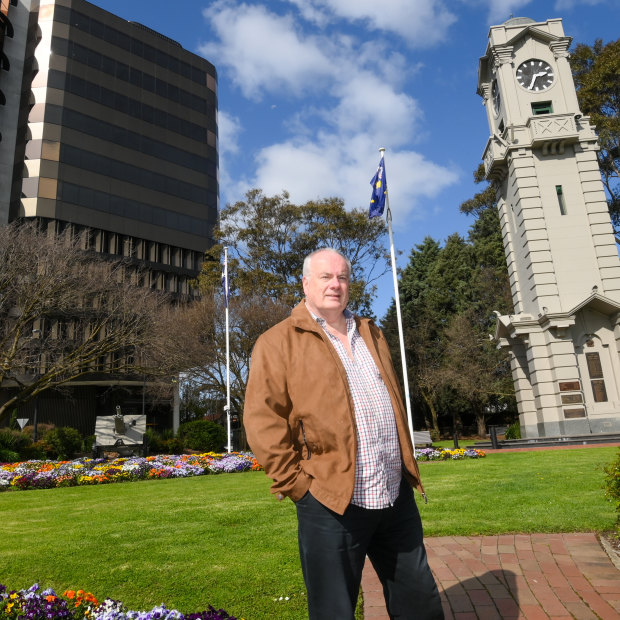
Lifelong Ringwood resident Russ Haines says locals have always cared deeply about the suburb’s iconic clock tower.Credit: Justin McManus
For generations, Ringwood’s clock tower has been the landmark locals use to orient themselves in this suburb in Melbourne’s outer east.
At nearly 20 metres high, it was the tallest structure in the area when it was built as a memorial for World War I soldiers in 1928 at the corner of Whitehorse and Warrandyte roads.
And the clock tower still loomed large even after it was taken down to make way for Eastland shopping centre and rebuilt just west of Ringwood station in 1967.
“We would say, ‘turn right at the clock tower’ – it was always a good landmark to go by,” says Russ Haines, who was born in Ringwood and has lived here for all his 71 years.
“Ringwood is very proud of the clock tower. A lot of organisations have it as their logo. It chimes on the hour and if there’s maintenance and they can’t turn on the chime, people ring in and say, ‘What’s happened?’”
Today, the clock tower remains an icon of Ringwood, but also serves as a yardstick to measure the scale of change and development in the suburb, which sits 24 kilometres east of the Melbourne CBD.
Already it is overshadowed by the VicRoads Customer Hub, which opened just behind it in 2022 and is 10 storeys high (including four storeys of car parking).
Its stature will continue to diminish, with more buildings that size and even taller set to sprout up nearby. The state government plans to turn Ringwood into a major “activity centre”, with high-density apartments envisaged around Ringwood station and the surrounding area.
Long a junction for communities in Melbourne’s outer east, Ringwood is in many ways now at its own fork in the road.
Wurundjeri Woiwurrung people of the Kulin nation lived around what is now Ringwood for at least 35,000 years, before European settlers violently dispossessed them from their land during the 1830s and 1840s.
By the late 1860s, colonists had established significant farms and orchards in the Ringwood area, which was followed in the 1870s and 1880s by a mining industry that dug out antimony, a mineral used for making pewter, rubber and paint.
An 1885 local travel guide remarked that raspberry farms took up “much of the cleared land of the countryside”, and that clay was being dug up and turned into bricks in nearby kilns.
The train line from Melbourne was extended through Ringwood in the early 1880s, initially to transport farm produce. A passenger station opened in 1889, triggering the development of Ringwood as a major township.
Farmland around Ringwood was subdivided after World War I, setting the scene for population booms after that war and again after World War II.
Families renting houses closer to Melbourne would travel to the area at weekends to gradually build their new homes.
Haines, who is president of the Ringwood and District Historical Society, says that when he was growing up in the area in the 1950s, it was still “very rural”.
“I spent a lot of my early life outdoors, chasing animals and climbing trees and various other things like that,” he says.
From its early days in colonial Victoria, Ringwood developed as a central point for travel and commerce between Warrandyte, Ferntree Gully, the Yarra Ranges and the Dandenongs.
Today, it sits at the fork of the Lilydale and Belgrave train lines, and at the intersection of EastLink and the Maroondah Highway.
Nowadays, people don’t roll in from the surrounding hills for mining and agriculture supplies, but to shop for high-end fashion at the huge Eastland shopping centre.
Built in 1966, Eastland underwent a $665 million redevelopment in 2016, which included the construction of the local council-owned Realm building, which houses a library and business centre, and the Ringwood Town Square, which is lined by restaurants, bars and cafes.
Maroondah City Council Mayor Kylie Spears, who has lived in Ringwood for the past 35 years, says the expansion of Eastland – in collaboration with council and with a focus on creating new community spaces – set Ringwood apart from other growing suburban activity centres.
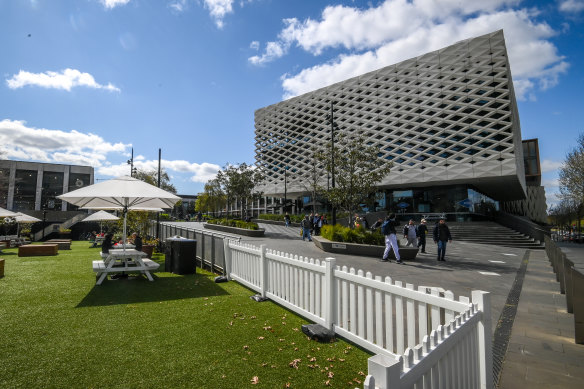
The 2016 redevelopment of Eastland included a new town square and library. Credit: Justin McManus
“We are the only metropolitan activity centre in Melbourne that actually has had over $2 billion worth of private investment – not public government investment, but private investment – to actually make our activity centre something amazing,” Spears says.
Spears says that Ringwood is a place where people can live close to nature and in leafy green streets while still having modern conveniences at their doorstep.
Ringwood’s natural qualities are accessible just a 10-minute walk from the bustle of the town square, at Ringwood Lake Park.
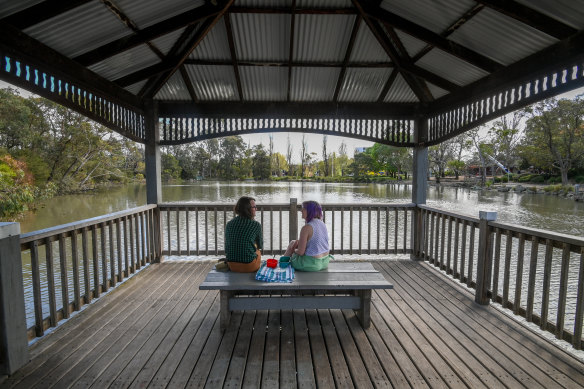
Ringwood Lake is a 10-minute walk from the hustle and bustle of Eastland. Credit: Justin McManus
When The Age visited this week, it was busy with families and locals eating lunch by the calm water and strolling along the park’s walking trails and wooden bridge.
Among them was Chi Chu, who moved to Ringwood from Box Hill four years ago with her husband and their cavoodle Reginald (who, as it turns out, is a social media star and influencer whose @reginaldthecavoodle Instagram account has almost 14,000 followers).
Chu is due to welcome her first child early next year, and says the area’s natural beauty and laid-back, country-town feel were major drawcards.
“I grew up in Chirnside Park, and this area seems so safe but it isn’t as far out as Lilydale,” Chu says. “There are lots of young families here – our neighbours are all young couples or young families.
“It is a really good area to raise kids, and there are a lot of good schools too. That’s part of the reason why my husband wanted to move to the area.”
Between 2011 and 2021, Ringwood grew from 16,000 people to 18,715, according to the Australian Bureau of Statistics.
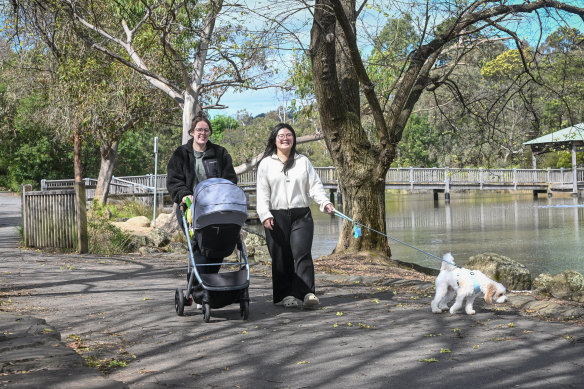
Chi Chu (right), with friend Nicole Dawson and Insta-famous dog Reginald, at Ringwood Lake Park. Credit: Justin McManus
Ringwood’s demography closely represents Victoria as a whole. The average age, 38, is bang on the statewide average. Median family income is just above the statewide average ($2157 versus $2136), while unemployment in 2021 was at 4.5 per cent, compared with 5 per cent statewide.
And 33 per cent of households use a language other than English at home, according to the ABS, which is slightly higher than the 30 per cent statewide average.
Ringwood’s multicultural community includes a high concentration of refugees and migrants from Myanmar, making up almost 3 per cent of Ringwood residents.
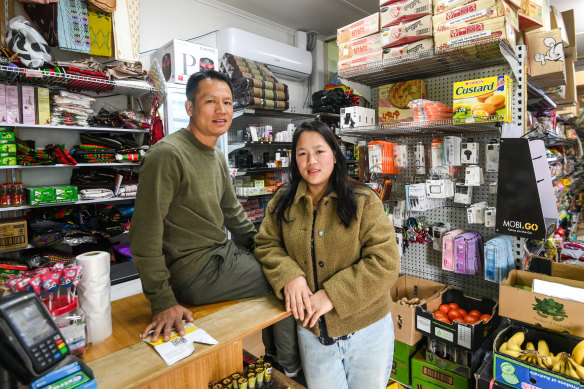
Thang (left) and Cing Khupmu, who are part of Ringwood’s large Burmese community, opened their shop near Ringwood station three years ago. Credit: Justin McManus
Over several decades, members of Myanmar’s persecuted ethnic minorities have gravitated towards Ringwood and other nearby neighbourhoods in the outer eastern suburbs.
That’s why Thang and Cing Khupmu settled in Ringwood when they first arrived in Australia as refugees from Myanmar 15 years ago.
Members of the Zomi people from western Chin state, they now have five children who are attending local schools. At first, Thang started a driving school for people from his community who were still learning English and then opened a successful grocery store just next to Ringwood station three years ago.
“Everything is good here in Ringwood. The community supports us,” Thang says.
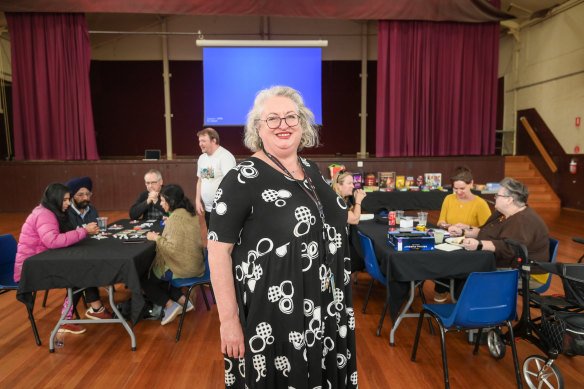
Ringwood Central Community Centre manager Cath Collopy. Credit: Justin McManus
Cathy Collopy, manager of the Central Ringwood Community Centre, says the growth of the Burmese community is one of the many changes she has seen during her 13 years at the centre.
Although it is only a short walk from the international fashion brands at Eastland, the community centre, nestled among gum trees and decorated with hand-painted murals, feels like it belongs in a country town hours outside of Melbourne.
On Thursday, the centre was holding its weekly migrant barista class – where students, mostly Burmese, work on both their English and latte-making skills – as well as art classes, an exercise dance group, and a community morning tea.
Collopy says the centre’s recently opened community garden would become an important outdoor space for residents moving into new apartment buildings.

Nick Allardice at his restaurant The Firehouse. Credit: Justin McManus
“It’s a very rich and varied population around the area,” she says. “There’s a big blend, with a mixture of reasonably affluent parts of Ringwood and in the more central area there’s social housing, and there’s a lot of people from different refugee and migrant communities.
“We’ve worked really hard to open up and broaden the range and scope of what’s offered to the community, and make the place feel comfortable and welcoming, no matter where you’re from.”
Nick Allardice bought the almost 100-year-old Ringwood Fire Station in 2019 and has turned it into The Firehouse, a trendy eatery consisting of a restaurant and huge beer garden, which heaves with patrons on summer days.
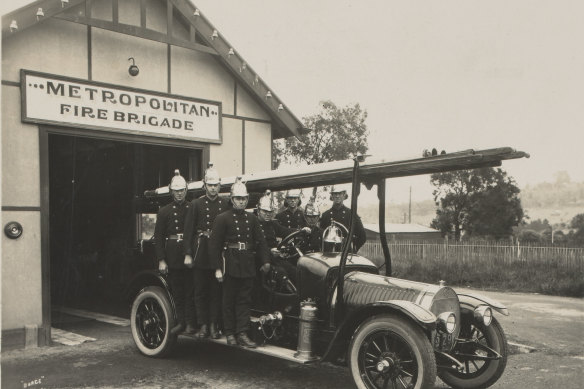
Officers and men of the Metropolitan Fire Brigade at the old Ringwood Fire Station in 1929.Credit: State Library of Victoria
Allardice says he has already seen a demographic shift over the past five years, with more customers interested in higher-end wines and fine-dining experiences.
“We find people going, ‘Hey, I can’t be bothered to go all the way into the city.’ Our customers say that it’s about getting CBD-style, Flinders Lane-style food, but in the suburbs,” he says.
In that respect, Allardice is hoping to capitalise on the expected development and population growth around central Ringwood.
“It’s a really good hub where people can live and not leave, and it’s very community oriented,” he says. “The increased population and better demographic is only a positive in my eyes.”
In September last year, the Victorian government’s Housing Statement named Ringwood as one of 10 “activity centres” to be focal points for higher-density housing development in Melbourne, as part of a plan to build 800,000 homes over the next decade.
A draft plan for Ringwood released last month says the activity centre – covering an area north of the train station up to Mullum Mullum Creek, and between EastLink and the Ringwood Lake Reserve – should be the site of between 8200 and 12,200 new homes.
The plan envisages apartment buildings of up to 15 storeys high in the central area around Ringwood station and Eastland, and developers are already preparing for projects of that size.
At the corner of Market Street and Maroondah Highway, the site of the old Jooce nightclub – which in the 1990s and early 2000s drew in revellers from across the outer eastern suburbs and boasted of being the biggest single-level club in the southern hemisphere – is advertised for sale with a development permit for 266 apartments.
Three sites – the tired Ringwood Square shopping centre, a concrete batching plant next to EastLink, and a mixed-used block next to Eastland – have been earmarked as “strategic development sites” ripe for buildings up to 20 storeys.
The activity centre plan shows that apartments of up to six storeys would be allowed across a broader catchment area that stretches out another 800 metres or so from the town centre.
Mayor Spears says the council and state government worked together carefully on plans to develop the central Ringwood activity centres around Eastland.
But she doesn’t support the new proposal to allow six-storey buildings across the large catchment area.
Spears says the number of new homes the government wants to build in Ringwood could fit into the central activity area, and so it was unnecessary to allow six-storey apartments in areas that largely consist of mostly single- and double-storey freestanding houses.
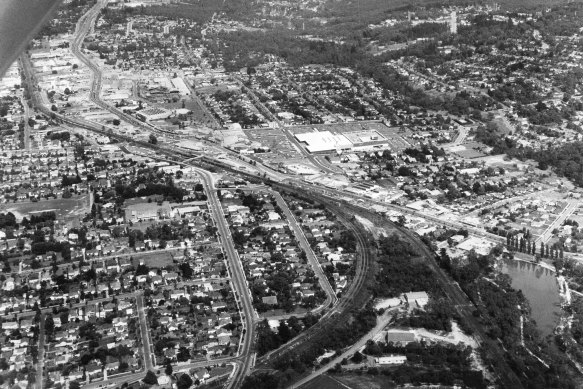
An aerial view of Ringwood in 1969: Shows the railway station, Town Hall and Eastland shopping centre in the centre of the photograph.Credit: John Lamb
“You do it [development] along our major roads, and not through our ridgelines and our slopes and not in our heritage areas,” she says. “They’ve done a cookie-cutter approach – we need a nuanced approach.”
Haines, the lifelong local, now has grandchildren living across the street from him. He says he hopes Ringwood maintains the qualities that have made it a special place for his family and many others.
“It’s a combination of the leafy parts of the suburb and the highly developed commercial area,” Haines says. “Places like Warrandyte, you get all the green, but you don’t get the access to the shopping areas. Ringwood’s got both of those.”
Start the day with a summary of the day’s most important and interesting stories, analysis and insights. Sign up for our Morning Edition newsletter.